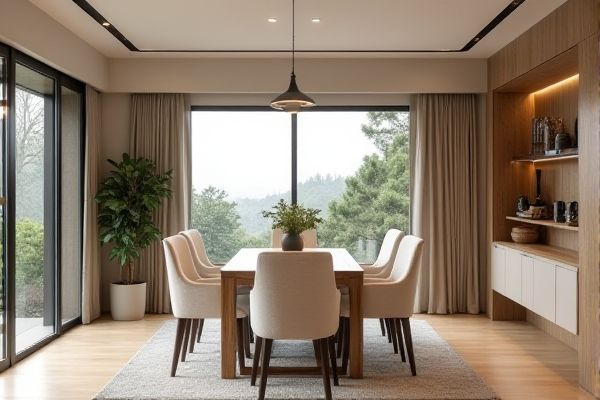
Sliding doors save space and offer a sleek, modern look for your dining area, while hinged doors provide a traditional aesthetic and can create a more defined separation between rooms. Explore the rest of the article to discover which option suits your dining space and lifestyle best.
Table of Comparison
| Feature | Sliding Door | Hinged Door |
|---|---|---|
| Space Efficiency | High - slides parallel to wall, saves floor space | Low - requires swing space to open |
| Installation | Complex - requires track and wall support | Simple - standard frame and hinges |
| Accessibility | Good - smooth sliding for easy access | Excellent - full opening width accessible |
| Maintenance | Moderate - track cleaning and alignment needed | Low - hinges occasionally lubricated |
| Visual Appeal | Modern, sleek look | Classic, traditional style |
| Cost | Higher - due to hardware and installation | Lower - simpler components |
| Noise Control | Moderate - slight noise from sliding | Better - tight seal when closed |
| Security | Moderate - locking mechanisms vary | High - robust locks and seals available |
Introduction: Choosing the Right Door for Your Dining Area
Sliding doors maximize space efficiency in dining areas by gliding parallel to walls, making them ideal for tight rooms and modern interiors. Hinged doors offer traditional aesthetics and a full-opening option, providing wide access suitable for larger spaces or classic designs. Selecting between sliding and hinged doors depends on room size, style preference, and functional requirements.
Design Aesthetics: Sliding vs Hinged Doors
Sliding doors offer sleek, modern design aesthetics with clean lines and minimal hardware, creating an open and airy feel in your dining area. Hinged doors provide a classic and versatile look, allowing for bold design choices with paneled or decorative styles that complement traditional or contemporary interiors. Your choice between sliding and hinged doors will impact the visual flow and spatial dynamics, enhancing the dining area's overall ambiance.
Space Efficiency and Room Layout
Sliding doors maximize space efficiency by gliding along the wall, eliminating the clearance needed for swinging doors and allowing more flexible furniture arrangement in your dining area. Hinged doors require a designated swing radius, which can restrict room layout and reduce usable floor space. Choosing sliding doors enhances flow and openness, particularly in compact or modern dining spaces.
Ease of Access and Functionality
Sliding doors offer superior ease of access in dining areas by gliding smoothly along tracks, requiring minimal clearance space and allowing uninterrupted passage. Hinged doors, while providing a traditional aesthetic, can restrict movement and reduce usable space due to their swing radius, impacting functionality in tighter dining rooms. Your choice between sliding and hinged doors should consider the spatial layout and frequency of access to maximize convenience and usability.
Natural Light and Openness
Sliding doors maximize natural light and maintain openness in your dining area by featuring large glass panels that allow unobstructed views and sunlight flow. Hinged doors often limit light and space due to their swing radius and solid structure. Choosing sliding doors enhances brightness and creates a seamless connection between indoor and outdoor spaces.
Privacy Considerations
Sliding doors offer moderate privacy in dining areas by providing a physical barrier, though gaps between the door and frame can allow sound to pass through more easily than hinged doors. Hinged doors provide superior privacy by sealing the space more effectively, reducing noise transfer and maintaining a distinct separation from adjacent rooms. Choosing sliding doors with enhanced seals or frosted glass can improve privacy while preserving a modern aesthetic.
Installation Process and Structural Requirements
Sliding doors require a track system installed either on the top or bottom of the doorway, which can involve modifying the wall structure to accommodate recessed tracks or pocket frames, potentially increasing installation complexity. Hinged doors necessitate adding sturdy door jambs and hinges mounted directly to existing wall framing, making installation more straightforward but dependent on sufficient wall space for door swing. Structural requirements for sliding doors often demand reinforced headers to support the weight and smooth operation, while hinged doors rely more on the integrity of the door frame and wall studs for stability.
Maintenance and Durability
Sliding doors in dining areas typically require less frequent maintenance due to fewer moving parts than hinged doors, which rely on hinges that may wear out over time. The durability of sliding doors is enhanced by their track systems that distribute weight evenly, reducing stress and potential warping, whereas hinged doors often face stress at the pivot point. Regular cleaning of sliding door tracks and proper lubrication ensures longevity, while hinged doors demand periodic hinge tightening or replacement to maintain smooth operation.
Cost Comparison: Initial and Long-term Expenses
Sliding doors for dining areas generally have higher initial costs due to specialized tracks and installation requirements, while hinged doors are typically more affordable upfront. Over time, sliding doors may incur additional maintenance expenses for track cleaning and roller replacement, whereas hinged doors often require less upkeep but might need hinge or frame adjustments. Considering energy efficiency, sliding doors can reduce heating and cooling costs with better sealing options, potentially offsetting their higher initial price compared to hinged doors.
Ideal Scenarios: Which Door Suits Your Dining Space?
Sliding doors optimize space in compact dining areas by eliminating swing clearance, making them ideal for tight layouts and modern interiors. Hinged doors suit larger dining rooms where traditional style and full-door access enhance aesthetics and ease of movement. Evaluating room size, traffic flow, and design preferences ensures selecting the perfect door for your dining space's functionality and style.
 homyna.com
homyna.com